Samsung Galaxy S7 edge vs Apple iPhone 6s Plus
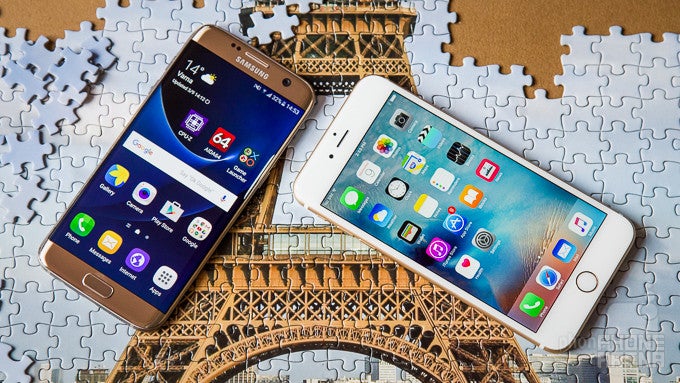
Introduction
It won't be far fetched to say that Samsung pulled an 'Apple-like' move with its Galaxy S7 this year. The new phone has been substantially overhauled on the inside when stacked against the Galaxy S6, but on the outside, it looks more or less identical. The situation with the Galaxy S7 edge is a bit different, primarily because it has grown in size compared to the Galaxy S6 edge. This makes it a potentially fearsome competitor to the iPhone 6s Plus, which happens to be in the same display size category.
The iPhone 6s Plus is undoubtedly the most advanced iPhone Apple has ever made, pairing the good-ol' design of the iPhone 6 Plus with overhauled hardware and exciting new functionality like 3D Touch. And even though it is six months old by now, we're pretty sure that it will give the Galaxy S7 edge a run for its money. Let's see how the two phones compare.
Design
The Galaxy S7 edge won us over with its more compact size and slick aesthetics. And it is water-resistant!
It's safe to say that the Galaxy S7 edge is the more attractive of the two phones. It's not necessarily the more beautiful, as that's a subjective matter, but Samsung's new phone easily draws attention from afar. Large part of this is due to the dual-curved 'edge' display at the front – it not only looks fancy, but also gives the impression of having no side bezels due to the way the glass edge wraps around the sides. The glass-on-metal construction further contributes to the device's sci-fi look. In contrast, the iPhone 6s Plus sticks to a more traditional design, revolving around pleasing aesthetics, symmetry, and coherency. Its no-frills aluminum unibody and curved sides are conservative in comparison, but the resulting looks and feel of the phone have their fair share of fans.
From a purely practical standpoint, we are struck by how bulkier the iPhone 6s Plus is in comparison with the much lighter and more compact Galaxy S7 edge – undeniably a win for Samsung's new pride and joy. Samsung's curvy phone is leaps and bounds ahead of the 6s Plus in terms of screen-to-body size distribution, as both phones have 5.5 inches of display up front, but the Galaxy S7 edge fits it into a smaller footprint. This is why the latter is a bit easier to handle and more comfortable to use.
Speaking of practicality, neither of the two designs is perfect; they both have their strengths and weaknesses. For example, being dust- and water-resistant is a key design advantage for the Galaxy S7 edge – even if you dip it in water or spill a drink all over it, the phone will live to tell the tale. Better yet, no ugly flaps cover any of the phone's ports. The iPhone 6s Plus, on the other hand, has a lesser chance of surviving such an encounter. But we're disappointed to see that fingerprints stick to the Galaxy S7 edge's glass surface like paperclips to a magnet. On the other hand, the iPhone 6s Plus holds virtually no fingerprint smudges onto its metal surface.
Display
Although it's hard to discern a clear winner, the Galaxy S7 edge gets in the lead
At 5.5 inches, both the Galaxy S7 edge and the iPhone 6s Plus give an identical allowance of screen real estate. Where the two differ is in the number of pixels packed within their respective panels, with the Galaxy S7 edge winning the race with its 1440 x 2560 (vs 1080 x 1920) resolution. In the real world, however, this supposed advantage has more to do with bragging rights than actual user experience benefits – the screens are just too small for a regular Joe to appreciate the difference.
But how do the displays of the two compare in other areas? Well, the Galaxy S7 edge in its Basic display mode has the upper hand in the color accuracy department, meeting more targets on the sRGB color gamut chart. That's mostly visible with the various cyan, blue, and purple hues. However, there's a catch. Basic display mode, despite being more color-accurate, is not enabled by default. Out of the box, the Galaxy S7 edge is set to Adaptive screen mode, which trades color accuracy for vividness and saturation. Similar is the case with the AMOLED Cinema and AMOLED Photo modes. Whether you'll be bothered by the color infidelity is another story, but that's unlikely. We don't have different display modes on the iPhone 6s Plus, but that's hardly an issue, as its color reproduction is great as it is.
The iPhone is able to hit a greater peak brightness than the S7 edge, 593 vs 493 nits, with automatic brightness enabled. This should give the former the upper hand when it comes to outdoor visibility, although the Galaxy S7 edge also fares well in this respect. And when it comes to minimum brightness, both screens go pretty low – 2 nits for the Galaxy S7 edge and 5 nits for the iPhone 6s Plus – meaning that both will go easy on your eyes in the dark before bedtime. Viewing angles are excellent with both phones, in case you're wondering.
Lastly, the iPhone is more consistent in its gamma reproduction. It exhibits excellent gamma values across all points of the grayscale, which are rather close to the perfect gamma reading of 2.2 at all times. On the contrary, the S7 edge tends to display the various shades of a tad more brightly than they have to be.
Interface and functionality
Neither brings a knife to the gunfight, as both the iPhone and the Galaxy have formidable arsenals of features
With the latest and greatest iterations of iOS and Android on board, the iPhone 6s Plus and the Galaxy S7 edge are merely two chapters in the never-ending battle between the two platforms. Each has its own pros and cons, which are fairly well-known at this point.
The S7 edge comes with Samsung's custom UI based on Android 6.0 Marshmallow. To no surprise, it comes with the plethora of features we know from last year's models, many of which can be pretty useful – from the side-by-side multitasking and the Flipboard-powered news feed to the built-in support for themes and S Health. In fact, the user interface has gained even more tricks that set the Galaxy S7 edge apart.
One such feature is Edge UX. The Galaxy S7 edge comes with customizable edge panels, accessible with an inward swipe from either edge, that provide users with shortcuts to various apps, tools, favorite contacts, and actions. For instance, you may take a peek at the weather forecast without closing the app you're currently in, or jump straight to the camera's selfie mode from almost any screen. Some might say it's a gimmick, but others might find it useful.
Additionally, Samsung has thrown in the new Always-On display functionality, which is practical. Basically, it shows useful bits of info like the time, date, calendar, or an image at all times when the phone is in stand-by. In other words, you don't have to turn on the whole screen just to see the time or whether you have any missed calls, and since it's an AMOLED display we have here, the feature's impact on battery life should be minimal.
The Game Launcher feature is also new. It provides a set of game-related features like recording gameplay videos, limiting the amount of obtrusive notifications that can pop up, and so on. Hardcore games might find this perk very useful.
Another fresh new trick is the Cross App multi-window mode. When using Samsung's messaging app, it lets you open links in a browser window in the bottom display half without leaving your chat thread. Videos you're sent can also be played in a similar fashion.
And then there's the iPhone 6s Plus. It comes with iOS 9.2.1, as of this writing, which does not have any edge overlays, does not have Always-On display, does not have a Game Launcher, or any of the bells and whistles you'd be getting with the Galaxy S7 edge. But the iPhone 6s Plus is as intuitive and smooth as ever, with nothing getting in the way of a pleasant user experience. With its no-nonsense approach to user interface and rich arsenal of quality-made apps, the iPhone is a reliable, easy-to-use handset.
That is not to say that the iPhone 6s Plus is any less functional. Spotlight Search, for instance, is only at a swipe's distance and lets you search through your phone or on the web, besides giving suggestions for news stories you might like and places of interest nearby. Night Shift, available in iOS 9.3 beta, aims to make falling asleep easier by adjusting the color temperature of the display. But one of the phone's most peculiar features is the 3D Touch display, which is able to discern between light taps and hard presses. This unlocks a whole new level of interaction across the interface and within apps that take advantage of the feature. You can now 3D-Touch homescreen icons to get quick-access shortcuts to sub-menus, you can take quick peeks at your emails, you can view the Live Photos in your gallery, to give a few examples.
Performance and memory
Blazing fast versus blazing fast! Pick the winner yourself
Comparing the chipsets of the S7 edge and the iPhone 6s Plus side-by-side is pointless — specs alone are certainly not painting the whole picture. Benchmarks shine a bit more light on the matter, but handling the devices yourself is the single best way to compare an iPhone with a non-iOS device.
Now, for the Galaxy S7 and Galaxy S7 edge, Samsung is going back to the old arrangement: a Qualcomm Snapdragon 820 chip powers units sold in the US, while its home-grown Exynos 8890 SoC hums under the lid of phones sold in most other regions. But the performance of both chips should be similar or identical in actuality, despite the technical differences between them.
Although the Galaxy S7 edge beats or is on par with the iPhone 6s Plus in most benchmark tests, in real life, both perform similarly and feel equally snappy.
There are 4 gigs of RAM on the S7 edge, while the iPhone 6s Plus has 2GB of the precious hardware resource. Despite this glaring difference, the memory management of iOS propels it to be on par with the better-specc'd Samsung device. We had no issues with switching back and forth between apps on either handset.
In terms of storage, Samsung offers 32 or 64 gigs right out of the box, but it also comes with a microSD card slot. This means you may add tons of extra storage on the cheap, just make sure that the card you're getting is fast enough to not slow down your handset. The iPhone offers no expandable storage and its base version comes with only 16GB natively, which isn't much by today's standards. You can also have it with 64 or 128GB, but this will cost you.
Camera
It's hard to choose between such well-performing adversaries
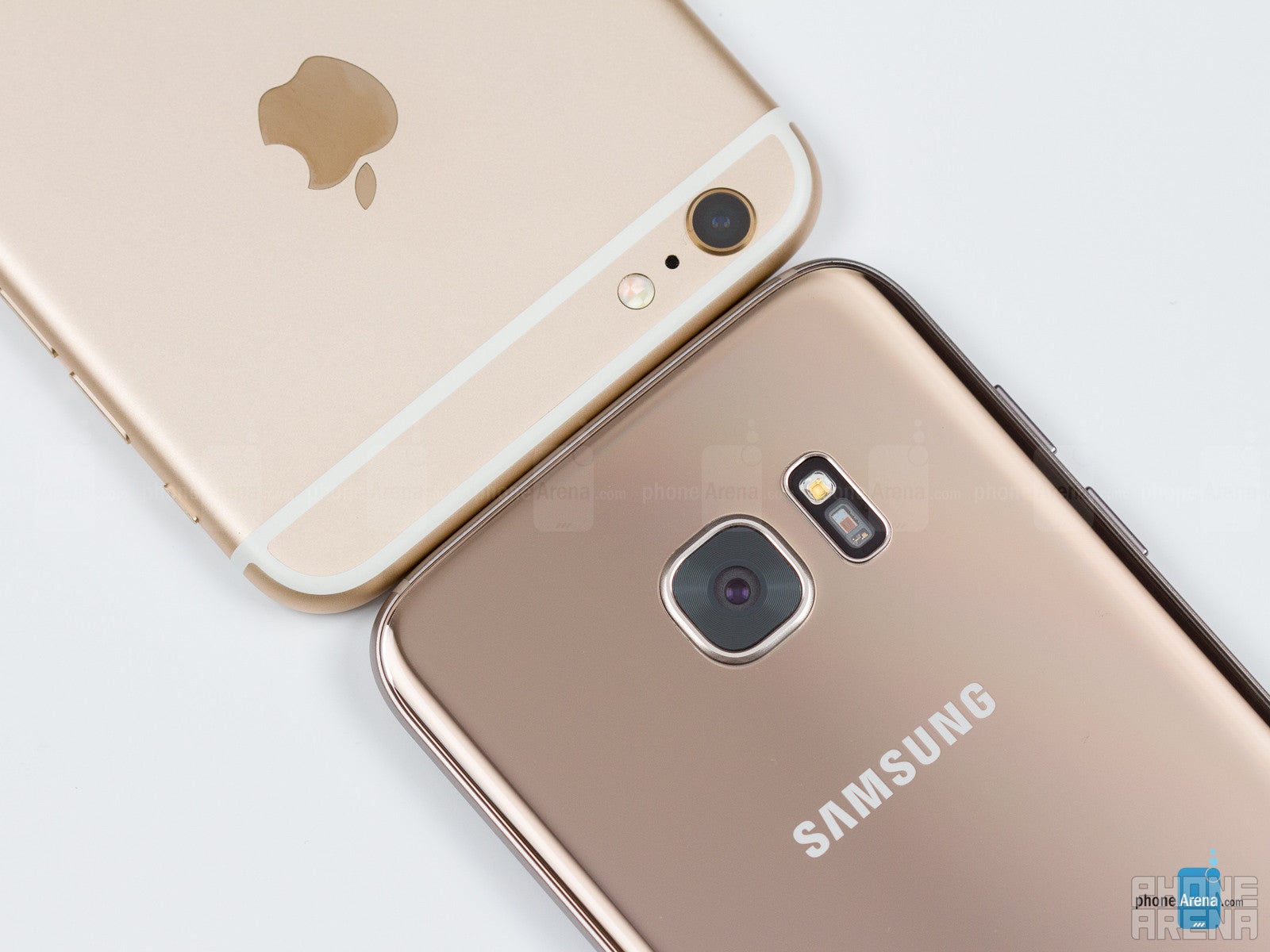
Despite the technical differences, the two champs performed similarly well in our camera match-up. Detail-wise, the S7 edge has a slight advantage in most situations, including in bright daylight and in low-light scenarios. It's less prone to blurring as it snaps pictures with a faster shutter speed in comparison with the iPhone 6s Plus. This is largely due to the larger aperture which sucks up more light for the same amount of time.
In terms of color accuracy, the iPhone 6s Plus tends to produce slightly warmer stills than its able-bodied competitor. Indeed, the S7 edge has superior color accuracy in certain scenarios, but in many others the two phones fare in a similar fashion.
You can shoot 4K videos with either device. In terms of details, it's hard to pick a clear winner, so let's agree that you can go wrong with neither. Same can be said about the exposure of the video clips, as well as their overall quality. Yet, the S7 edge won us over! It made us swoon over its ultra snappy autofocus which locks in in a jiffy, while the iPhone 6s Plus takes a bit longer to do the same exercise. Additionally, the iPhone's audio-recording capabilities are noticeably inferior and sound unpleasantly muffled. The S7 edge is not without its minor issues – rolling shutter can be observed in the 4K footage we recorded, while the iPhone hardly exhibited any. In 1080p videos though, the S7 edge had no such problems.
Multimedia
Consuming media on either phone is a pleasant experience... as long as you don't mind the curves.
With such large and high-quality displays, consuming media should be a pleasant experience on either the S7 edge or the iPhone 6s Plus. But in actuality, the iPhone 6s Plus is at a slight advantage. You see, the edges of the Galaxy S7 edge curve the image slightly while watching photos or full-screen video, and that might annoy the perfectionists among us.
One department where you can get disappointed is the potency of the loudspeakers on the two devices. True, we will have to nitpick hard before we can find a weak spot in the audio quality on either phone (they are quite good, though not the very best we've heard), but you are quite likely to struggle with the loudspeakers in noisier environments. However, we will pick 'good' over 'loud' any time of the day!
In terms of software features, each has its own set of skills. The iPhone comes with a slew of preloaded media apps that are deeply-integrated in the operating system and feel a tad more intuitive to use. Apple Music is a good example of this. In Samsung's camp, we notice that the stock Galaxy music player has been nixed, replaced with Google's Play Music for local playback and Samsung's Milk Music for streaming.
Call quality
True to its flagship status, the duo performs excellently
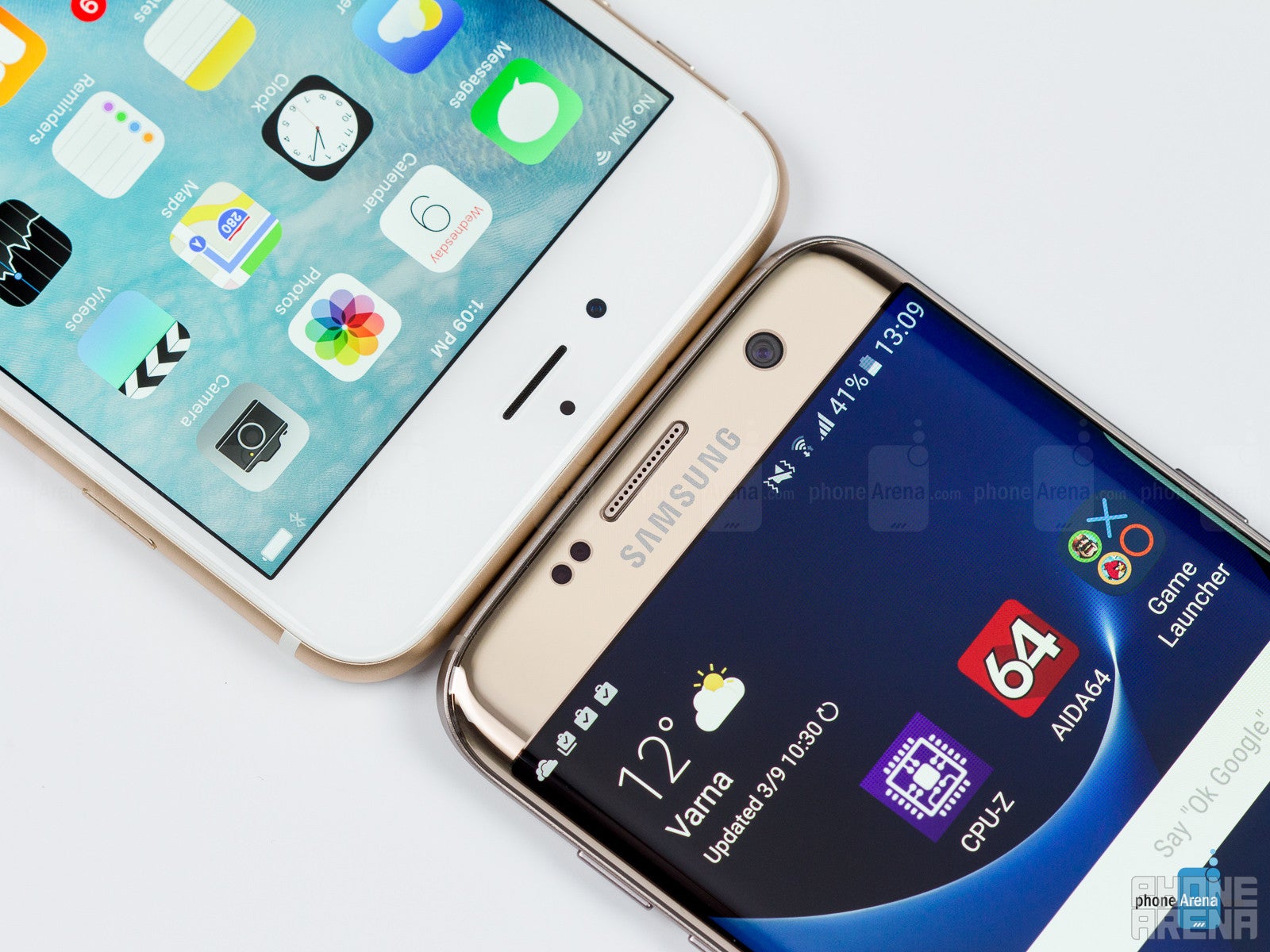
In the other camp, iPhones have never been known to offer the best-in-class call quality, but they are usually among the top-performing ones. The 6s Plus is no different — it delivers an acceptable performance through its earpiece, which happens to deliver strong tones that make it audible in noisy environments. Sure, there’s a little bit of crackle in the voice of our callers, but generally speaking, there’s good enough fidelity and clarity to carry on conversations.
Battery
All hail Apple's optimizations!
Sporting a beefy, 3,600mAh non-removable battery at its back, the Galaxy S7 edge will easily last you a day of normal use. Of course, you can eke out even more if you go lighter on the device, but all in all, we are a bit disappointed by the mostly average battery life of the Samsung device, which a slight downgrade in comparison with the S6 edge.
The iPhone 6s Plus arrives with a 2,750mAh battery that would easily last you a day and a half, and even two days and more with lighter use. This is largely due to the insanely-good power efficiency in standby mode, which is the chief reason for the admirable battery life in real-life scenarios.
What about benchmark testing? We ran our battery life test where we equalize conditions: we set both screens to 200-nit brightness, a level quite comfortable for indoor use, and started a custom script that mimics typical smartphone usage, which doesn't feature any screen-off time. The results? The S7 edge lasted for 7 hours and 18 minutes, while the iPhone 6s Plus clocked in at 9 hours and 11 minutes.
However, when it comes to recharging the battery the S7 edge has the upper hand. It supports fast wireless charging and is able to get a full charge in 99 minutes, though a 15- or 30-minute rendezvous with the charger will give you hours' worth of battery life. The iPhone 6s Plus, on the other hand, has neither fast nor wireless charging on board, and takes 165 minutes for a full charge.
Conclusion
Now is the time for us to say which of these two phones is better than the other, but that's tricky, to say the least, knowing that both have a lot to stand their grounds with. The shiny new Galaxy S7 edge won us over with its more compact dimensions, unusual design, and camera that performs rather good in low-light situations. Plus, we do appreciate the benefits of having expandable storage and the peace of mind, knowing that the handset is water-resistant. If you're the kind of person that lives and breathes smartphones, that likes to be on the cutting edge of technology, that enjoys knowing that the handset in their pocket is packed to the brim with features, then the Samsung Galaxy S7 edge is the phone you should take a look at.
On the other hand, the iPhone 6s Plus is a worthy rival with its superior software user experience and killer app ecosystem. It isn't that big of a match for hardcore geeks as the S7 edge, but it is a great choce for those looking for a no-nonsense smartphone that does it all, without the unnecessary bells and whistles. Sure, it might not be water-tight, but our tests show that it stands taller than the S7 edge when it comes to battery life.
Ultimately, it is up to you to decide which phone to pick - the Samsung Galaxy S7 edge or the iPhone 6s Plus. In our opinion, you can't go wrong with either of them.
Samsung Galaxy S7 edge
Pros
- More compact
- Outstanding design
- Display with superior color accuracy in Basic mode
- Better low-light camera performance
- Water resistant
Apple iPhone 6s Plus
Pros
- Holds no fingerprint smudges
- Tons of high-quality apps
- Superior battery life

Follow us on Google News
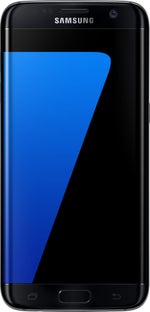
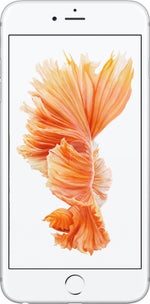




















Things that are NOT allowed:
To help keep our community safe and free from spam, we apply temporary limits to newly created accounts: